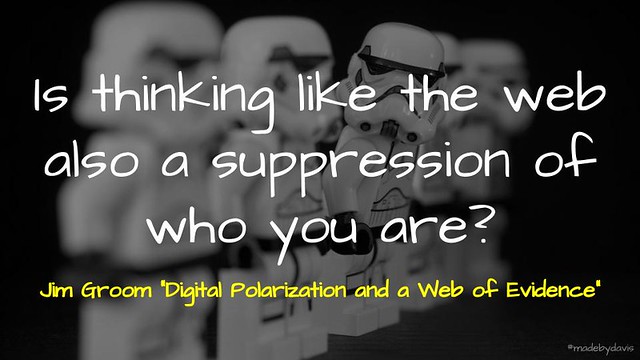
“Who You Are @jimgroom” by mrkrndvs is licensed under CC BY-SA
This post is intended to document my Wikity journey. I had been meaning to investigate the idea further after reading Michael Caulfield’s reflections on the project at the end of the year. However, it got put on the backburner for a number of reasons, one of which was my concern about the time and effort that it would require. I thought about it again while listening to Martha Burtis talk about Domain of One’s Own. One of the questions Burtis asks is how aware we were about dealing with digital problems. It occurred to me that although I was confident in setting up an instance of WordPress or creating a sub-domain, I was inadvertently avoiding going any further. So I dived back in, created a new sub-domain (wikity.readwriterespond.com) and loaded up a new instance of WordPress.
So what is a Wikity anyway? Caulfield explains,
The idea is other people’s investigations or explanations of things feed into what you are exploring; you add your bit to that and feed it forward for others to use. At the same time, since people work in their own space, everybody gets to keep control of their own process, built to achieve their own ends.
Structurally, it is a theme built upon WordPress and involves writing short ‘posts’ collecting chunks of text and providing elaborations and tags. These may be your own or they could be forked from other Wikity instances. Originally, you could set up an account at Wikity.cc, but now need to run your own instance using the code made available via GitHub.
Although it could be construed as a form of social bookmarking, it is different to something like Diigo in that it is designed to fork, revise and link between cards. It is also not designed as a centralised hub, as the focus is on the divergent collection of ideas and sharing them on a peer-to-peer basis.
For example, maybe you are reading an essay on listening and in the process it talks about the difference between talking and listening:

“Wikity Understanding” by mrkrndvs is licensed under CC BY-SA
As well as the idea of editing being an act of listening:

“Wikity Writing and Listening” by mrkrndvs is licensed under CC BY-SA
Although these posts are similar, they represent different ideas.
In regards to content and workflow, there are many similarities with the way I create my newsletters. Once I have found something interesting, I write a short summary and then add a quote. The differences with a Wikity is the continual development of cards over time and the focus and themes and ideas.
I wonder if Wikity is best conceived as a footnote for the web? With this in mind, I am left thinking about how this might be different to Hypothesis? Maybe there is a potential when converging my thoughts to reference the various cards, rather than the original posts? With all this said, there is one wicked question posed by Jim Groom that lingers in particular, “Is thinking like the web also a suppression of who you are?” I fear that I have actually yet to suppress my writerly identity?
So that is my take on Wikity? What about you? Do you do anything similar? As always, comments welcome.
Read Write Wikity by Aaron Davis is licensed under a Creative Commons Attribution-ShareAlike 4.0 International License.


I feel that I do this with my space. I often reference past posts. However, I wonder if a wiki would be better. I did tinker with the idea in regards to Wikity, but I ended up bringing that content back into my site.
Chris, I really enjoyed your thoughts and reflections on Wikity. I haven’t really used it for a while. In some ways it was a part of my first tinkering with the idea of a commonplace book. I eventually brought my posts there into my ‘collect’ blog.
I really like your idea about a plugin and would definitely be up for that. It reminds me of what Alan LevineAlan Levine has done with the Splots Writer plugin. This is also how EdublogsEdublogs have built wikis their version of WordPress.
Across a series of posts (1,2,3), Steve Brophy explains his use of Roam Research and the Zettelkasten methodology to develop a deeper dialogue with what he reads. This is broken up into three steps, the initial capturing of ‘fleeting notes‘, rewriting the text in our own words as ‘Literature Notes‘ and the creation of declarative statements in the form of ‘permanent notes. He elaborates this all in the following video:
This has me re-thinking what Mike Caulfield was trying to achieve with Wikity. I am also left thinking about Ryan Holiday’s advice in regards to how to ‘read to lead’, as well as Julie Beck’s point to simply do something. Personally, I think that the biggest challenge is actually capturing the ideas when they arise.
For something a bit longer, find this guide from Thriving Henry, while Dave Winer demonstrates how to achieve the same outcome with Little Outliner.